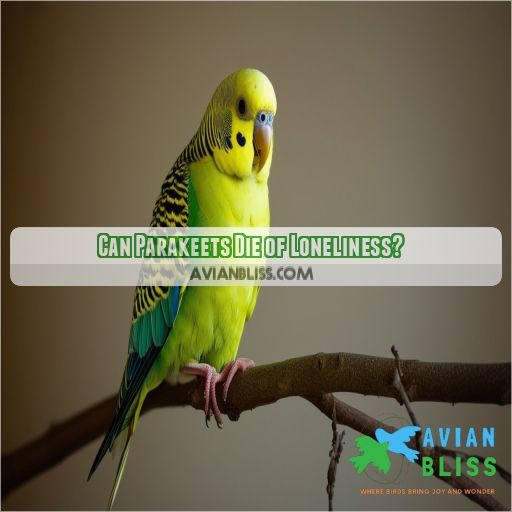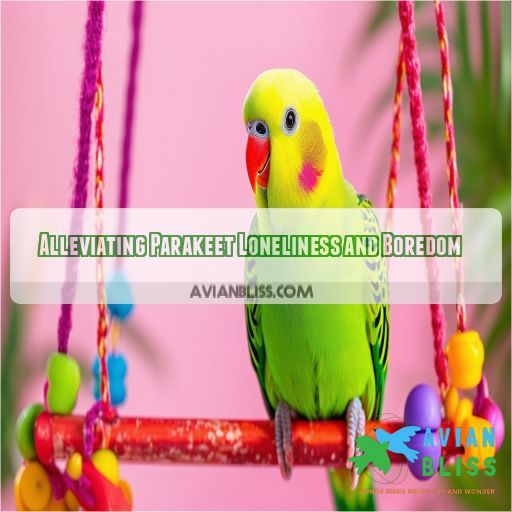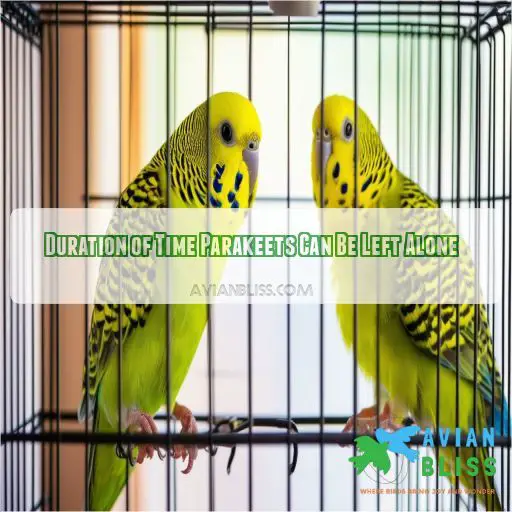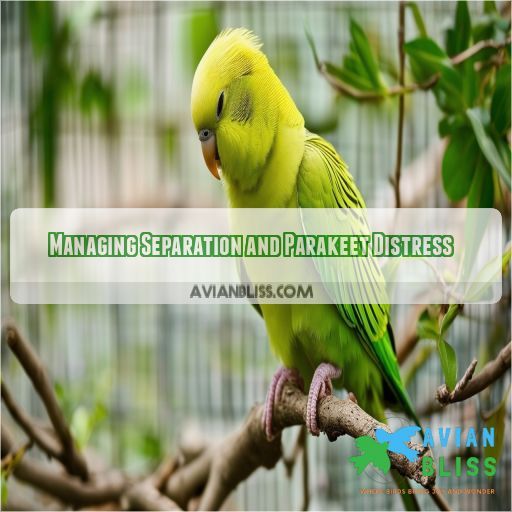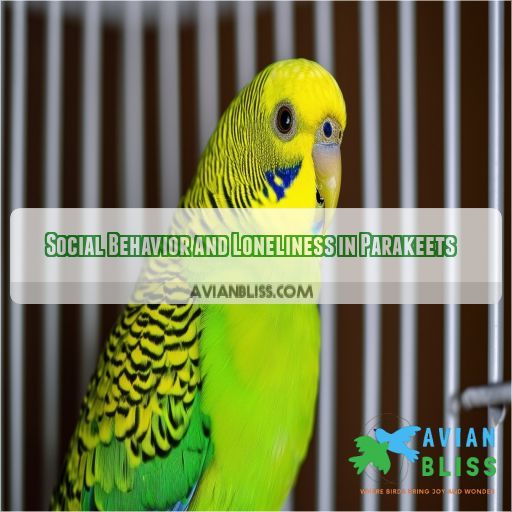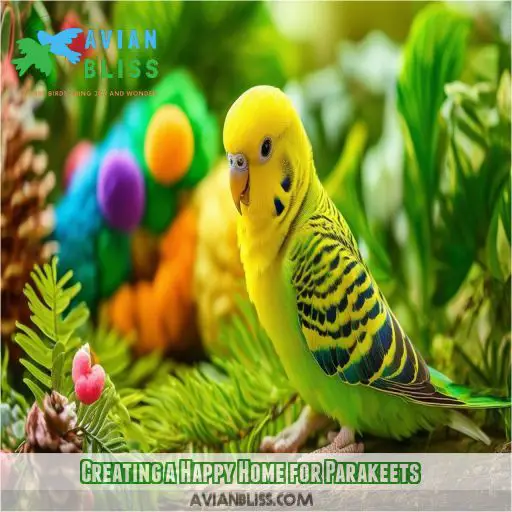This site is supported by our readers. We may earn a commission, at no cost to you, if you purchase through links.
 Like a lonely heart yearning for companionship, parakeets can suffer from isolation. You might wonder, will a parakeet die of loneliness? While it’s unlikely to be the direct cause of death, prolonged solitude can seriously impact your bird’s health and happiness.
Like a lonely heart yearning for companionship, parakeets can suffer from isolation. You might wonder, will a parakeet die of loneliness? While it’s unlikely to be the direct cause of death, prolonged solitude can seriously impact your bird’s health and happiness.
Parakeets are social creatures that thrive on interaction. Understanding their needs and providing proper care is essential for their well-being.
This guide will explain how loneliness affects parakeets and offer practical tips to keep your feathered friend content, healthy, and chirping with joy.
Table Of Contents
- Key Takeaways
- Can Parakeets Die of Loneliness?
- Alleviating Parakeet Loneliness and Boredom
- Duration of Time Parakeets Can Be Left Alone
- Managing Separation and Parakeet Distress
- Social Behavior and Loneliness in Parakeets
- Creating a Happy Home for Parakeets
- Frequently Asked Questions (FAQs)
- Can budgies die of loneliness?
- Will a parakeet get lonely?
- How long can a parakeet stay alone?
- Can a parakeet live alone after one dies?
- How quickly can loneliness affect a parakeets health?
- Can parakeets form bonds with non-bird pets?
- Do parakeets prefer same-sex or opposite-sex companions?
- Are some parakeet breeds more prone to loneliness?
- How does seasonal change impact parakeet socialization needs?
- Conclusion
Key Takeaways
- Parakeets are social butterflies with wings! While they won’t drop dead from loneliness, a life without feathered friends or human chit-chat can ruffle their feathers and lead to a serious case of the blues.
- Think of your parakeet’s cage as their own little Disneyland. Deck it out with toys, perches, and puzzles to keep their birdie brains buzzing. A bored parakeet is like a comedian without an audience – not a pretty sight!
- Flying solo for a 9-to-5 workday won’t clip your parakeet’s wings, but extended alone time is a no-go. If you’re jetting off for a vacay, make sure to call in the parakeet-sitting cavalry.
- Parakeets are nature’s little extroverts. Whether it’s bonding with birdie buddies or becoming your new BFF (Best Feathered Friend), social time is the secret sauce to keeping your parakeet chirping with joy.
Can Parakeets Die of Loneliness?
Parakeets are inherently social creatures, and their well-being hinges on companionship. While it’s unlikely that your parakeet will die directly from loneliness, prolonged social isolation can severely impact their health and quality of life. You might notice behavior changes like decreased appetite, lethargy, or excessive vocalization. These signs can indicate your feathered friend is struggling with loneliness.
Chronic social isolation can lead to stress, weakened immune systems, and even depression in parakeets. Without proper stimulation and interaction, they may become susceptible to various health issues. It’s important to understand that parakeets thrive on social connections, whether with their own species or with you as their caregiver.
To support your parakeet’s mental and physical health, consider providing a companion bird or dedicating more time to interact with them daily. Remember, a happy parakeet is a healthy parakeet!
Alleviating Parakeet Loneliness and Boredom
To alleviate your parakeet’s loneliness and boredom, consider providing a feathered companion or dedicating more time to interact with your bird daily. Creating a stimulating environment with varied toys, perches, and activities can also help keep your parakeet mentally engaged and emotionally satisfied.
Providing Companionship
To alleviate your parakeet’s loneliness, consider getting a feathered friend. Parakeets are social creatures, and having a companion can work wonders.
Two males often bond well, while females may seek multiple mates. If you’re not ready for another parakeet, explore companion species.
Stimulating Environment
To keep your parakeet mentally stimulated and ward off loneliness, create an enriching environment. Here are four essential strategies:
- Introduce interactive toys that challenge your bird’s problem-solving skills
- Rotate toys regularly to maintain interest and prevent boredom
- Provide sensory stimulation through varied textures, colors, and sounds
- Consider species-compatible companions for social interaction
Duration of Time Parakeets Can Be Left Alone
While parakeets thrive on companionship, they can handle some alone time. You can leave your feathered friend for a normal workday without worrying about dire consequences. However, it’s imperative to balance solitude benefits with isolation dangers. To prevent boredom and separation anxiety, make sure your parakeet has plenty of entertainment options.
| Duration | Action | Benefit | Precaution |
|---|---|---|---|
| 8-10 hours | Open curtains | Natural light | Avoid direct sun |
| All day | Leave radio on | Stimulation | Moderate volume |
| 24 hours | Fresh food/water | Hydration | Clean bowls |
| 2+ days | Caretaker visit | Social interaction | Trustworthy person |
Managing Separation and Parakeet Distress
When your parakeet is separated from a companion or left alone, it’s essential to recognize signs of stress such as decreased appetite, quietness, or erratic behavior. To alleviate separation stress, provide new toys, treats, and increased interaction, which can help support your parakeet’s emotional well-being during difficult times.
Recognizing Signs of Stress
While parakeets can handle short periods alone, it’s essential to recognize signs of stress when they’re separated from companions. Your feathered friend may exhibit stressful behaviors that indicate they’re feeling lonely or anxious. Keep an eye out for:
- Excessive squawking or unusual vocal cues
- Feather plucking or self-mutilation
- Loss of appetite or weight changes
- Social withdrawal or decreased interaction
- Lethargy or reduced activity levels
Spotting these signs early can help you address your parakeet’s separation anxiety promptly.
Alleviating Separation Stress
To alleviate separation stress, focus on companion bonding and social enrichment. Spend quality time with your parakeet before leaving, providing treats and gentle interaction.
Leave enrichment activities like puzzles or new toys to keep them occupied. Consider environmental stimulation by placing their cage near a window or playing nature sounds.
Social Behavior and Loneliness in Parakeets
Understanding your parakeet’s social behavior is key to preventing loneliness. In the wild, these birds form large flocks with complex social hierarchies and intricate grooming behaviors. They communicate constantly through chirps and body language, maintaining strong bonds within their flock. This natural instinct for companionship doesn’t disappear in captivity.
Without proper socialization, your parakeet may become depressed or anxious. They’ll miss out on essential flock communication and mutual grooming, which are essential for their well-being. In their natural habitat, parakeets rely on each other for safety and emotional support. While you can’t replicate their wild environment entirely, you can provide a stimulating space that meets their social needs.
Creating a Happy Home for Parakeets
Creating a happy home for your parakeet involves providing a spacious cage with multiple perches, toys, and appropriate food and water bowls. You’ll also need to engage with your bird daily, talking to them, offering treats, and ensuring they’ve plenty of opportunities for exercise and mental stimulation.
Housing Considerations
When housing your parakeet, size matters. Choose a cage that’s wide and tall, giving your feathered friend room to spread its wings.
Mix up perch sizes and materials to keep those little feet happy.
Place the cage in a warm, active room with plenty of daily sunlight.
Don’t forget to provide some background noise – a radio can work wonders for your parakeet’s mood.
Daily Interaction
To keep your parakeet thriving, establish a daily routine that includes social bonding. Spend time talking to your feathered friend, mimicking their speech patterns. This interaction isn’t just fun; it’s vital for their emotional well-being.
Offer mental stimulation through toys and games, and let them out of the cage for supervised playtime.
Frequently Asked Questions (FAQs)
Can budgies die of loneliness?
Yes, budgies can die of loneliness. They’re social creatures that thrive on companionship. Without interaction, they may become depressed, stop eating, and develop health issues. It’s essential to provide them with companionship, either through another budgie or human interaction.
Will a parakeet get lonely?
Like a bird without its flock, your parakeet can get lonely. They’re social creatures craving companionship. You’ll notice changes in behavior if they’re feeling isolated. Providing a feathered friend or extra attention can keep their spirits soaring.
How long can a parakeet stay alone?
You can leave your parakeet alone for a workday, but not much longer. They need daily interaction and care. For extended absences, arrange a caretaker to guarantee your feathered friend stays happy and healthy.
Can a parakeet live alone after one dies?
While a parakeet can survive alone, it’s not ideal. You’ll need to step up as their companion, providing extra attention and stimulation. Consider getting another parakeet to prevent loneliness and maintain their social needs.
How quickly can loneliness affect a parakeets health?
Time flies when you’re lonely! Your parakeet’s health can decline rapidly without companionship. Within days, you’ll notice changes in behavior and appetite. In weeks, physical symptoms may appear. Don’t let your feathered friend suffer – act quickly.
Can parakeets form bonds with non-bird pets?
Yes, parakeets can form bonds with non-bird pets. You’ll often see them interacting with cats, dogs, or even rabbits. However, always supervise these interactions closely to guarantee your parakeet’s safety and well-being.
Do parakeets prefer same-sex or opposite-sex companions?
You might think parakeets are picky, but they’re quite flexible! While they can bond with either sex, same-sex pairs often get along well. It’s more about personality than gender. You’ll want to watch their interactions closely.
Are some parakeet breeds more prone to loneliness?
While all parakeets need companionship, some breeds may be more social. Budgerigars, for example, are known for their gregarious nature. You’ll find that providing adequate attention and stimulation is essential, regardless of the breed you choose.
How does seasonal change impact parakeet socialization needs?
You’ll notice your parakeet’s socialization needs change with the seasons. In spring and summer, they’re more active and social, while winter brings calmer behavior. Adjust your interaction and playtime accordingly to keep your feathered friend happy year-round.
Conclusion
Just as a garden flourishes with careful tending, your parakeet thrives on companionship and care. While a parakeet won’t die of loneliness directly, it’s important to understand how isolation affects these social creatures.
By providing a stimulating environment, regular interaction, and proper housing, you’ll help your feathered friend stay happy and healthy. Remember, parakeets need social bonds to truly flourish.
With the right approach, you’ll create a joyful home where your parakeet can thrive, chirping contentedly for years to come.

